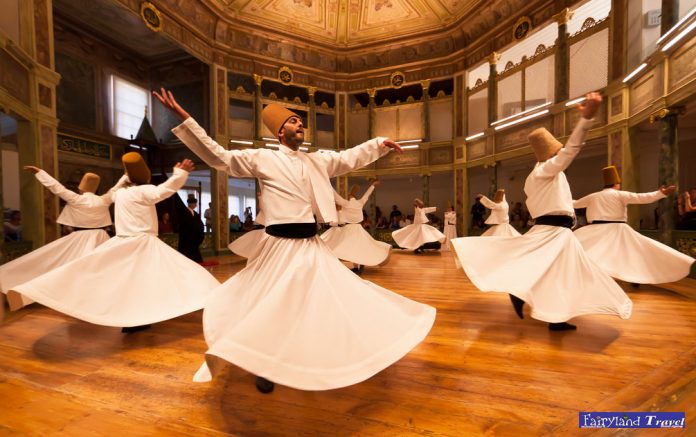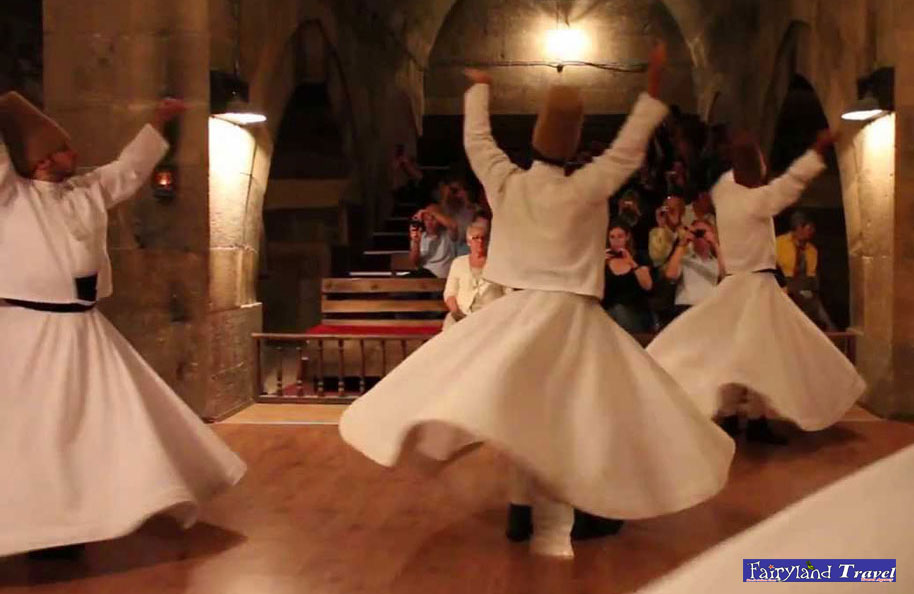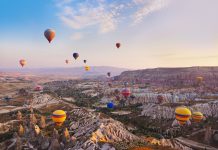Mevlana Museum in Konya
Sema (Whirling dervishes ceremony), is the inspiration of Mevlana Celaleddin-i Rumi from 12 th century ,it is part of Turkish culture, belief and history in Konya. It symbolizes the different meanings of a mystic cycle to perfection everthing turn around ALLAH. Contemporary science definitely confirms that the fundamental condition of our existence is to revolve. There is no object, no being which does not revolve. Every thing whirls and man, a whirling dervish, carries on his life, his very existence by means of the revolution in the atoms, structural elements in his body, by the circulation of his blood, by his coming from the Earth and return to it, by his revolving with the Earth itself.
The dervish with his hat , and his white skirt is spiritually born to the truth. When he removes his black cloak, he journeys and advances to the spiritual maturity through the stages of the Sema. At the beginning and each stage of the Sema holding his arms crosswise he represents number one, and testifies to God’s unity.
WHIRLING DERVISHES CEREMONY: 25 euro
Whirling Dervishes ceremonies start at 18:00 in winter and 21:00 in summer every night. The whole ceremony takes around one hour and we offer ‘Serbet’, (sweet water) drink, after the ceremony.we picks you up from your hotel in Goreme or other towns of Cappadocia than after the show take back to hotel.
CARAVANSERAI SARUHAN (SARIHAN)museum and ceremony place: 39.99 euro p.p
Whirling Dervishes ceremonies are performed in Sarihan Caravanserai everynight, but what is a caravanserai?
The Ceremony in Saruhan Trade across Turkey in medieval Seljuk times was dependent on camel trains (kervan, anglicised as caravan), which stopped by night in inns known as kervansaray (caravanserai), literally ‘caravan palaces’. These buildings provided accommodation and other amenities for the merchants and stabling for their animals. During the reign of the Anatolian Seljuk sultans Kilicarslan II (1155-1192) and Alaaddin Keykubat I (1220-1237), a large number of kervansarays were built and security measures along the Silkroad and other trade roads increased. The state not only built kervansarays but compensated merchants who were attacked or robbed, so providing a kind of insurance system. As a result, both domestic and international trade expanded. Foreign merchants who came to Anatolia enjoyed extensive rights and reductions on customs duties.
All merchants of whatever nationality were provided with food and beverages free of charge for three days. Their shoes were repaired and new shoes were given to the poor. Treatment was available for the sick, animals were cared for and shoed if necessary. Each kervansaray employed a physician, imam (priest), inn keeper, superintendent of provisions, veterinary surgeon, blacksmith and cook to provide these services.
Whirling Dervishes Ceremony The Silk Road caravanserais of Cappadocia were built of hewn volcanic stone, and their walls were thick and high so that they would be safe from raids by robbers. Decoration was concentrated on the great portals which display the finest examples of Seljuk stone carving. The portal doors were made of iron to repel intruders. Sarihan, situated 15 km from Goreme, on the east of Avanos, is on the banks of the Damsa brook. It faces west, and consists of an indoor area with five naves and a courtyard. Sari Han is considered to have been built in 1249. It had a Turkish bath and a mesjid over the gatehouse and its external area (excluding the towers and portal) is 2,000 square meters. After the restoration process, it represents the best example of Anatolian caravanserais. Please visit our “Caravanserais” page for further information about caravanserais in Cappadocia.









